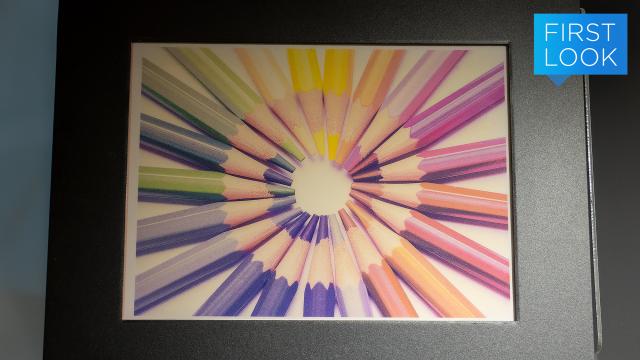E Ink not only weathered the arrival of the tablet (many predicted the iPad would kill off electronic paper ebook readers), it continues to thrive. But not as just a way to slap a low-power backup screen on laptops and smartphones. Today E Ink unveiled its next-generation electronic paper that could finally bring a welcome splash of colour to devices like the Amazon Kindle.
For the past few years at CES, E Ink has shown off prototypes of its colour electronic paper by using it to replicate famous works of art on an oversized digital photo frame. Because the E Ink technology is reflective, and visible without any side or backlighting, the images produced by the prototypes in the past genuinely looked like they’d been painted on a medium like canvas. The illusion was only shattered when the photo frames load the next image which required a redrawing process that, at times, if memory serves me correctly, could take up to half a minute. No one wants to wait that long for their favourite e-reader to display the next page of text or imagery.
The colour E Ink displays work similarly to the black and white versions currently used in devices like the Amazon Kindle. But instead of filling the tiny microcapsules that function as an E Ink display’s pixels with just black and white pigments, the colour version adds an array of coloured pigments that can be activated and combined in multiple passes to slowly build up a full colour image.
All in all, E Ink estimates that somewhere around 40,000 colours can be recreated by strategically mixing and combining the pigments. What E Ink announced at CES 2020 is that the company has managed to improve the technology so that a full page refresh can be completed in about two seconds, which, based on the demo I was given, feels more than fast enough for coloured E Ink to finally be adopted into devices such as the Kindle.
The results aren’t as saturated or vivid as the imagery reproduced on an LCD or OLED display, but E Ink has its own unique advantages over those technologies. It’s more durable, it’s flexible, it’s easy to see even in bright sunlight, and it uses very little power, to the point that when a colour image is created, it will remain on the screen indefinitely without the need for any external power whatsoever.
All the reasons consumers still flock to devices like the Kindle for reading ebooks still apply to colour E Ink. The only downside to companies like Amazon adopting the coloured electronic paper is that it will add some additional cost to devices as the electronics needed to generate the full colour imagery are a little more complex. But E Ink is working on ways to ensure that the cost increase won’t be a deterrent to consumers.
E Ink has also developed variants of the new coloured electronic paper with versions that are able to produce more vibrant colours, but with a smaller palette overall. The company envisions these screens for use in stores and shopping centres where signage is first and foremost designed to catch a shopper’s eye, with colour accuracy taking a back seat.
While the colour E Ink signage is now available to developers looking to integrate it into digital signage products, there’s no timeline on when the E Ink screens supporting the larger colour spectrum will start showing up in consumer devices. But you’ve waited this long for a colour Kindle that will finally display your digital comic books how they’re meant to be seen, so what’s another year of waiting?
